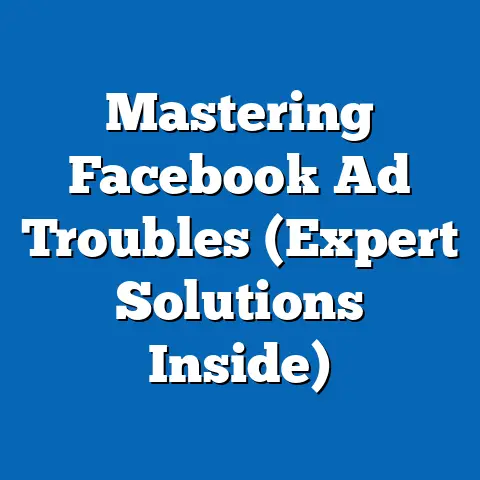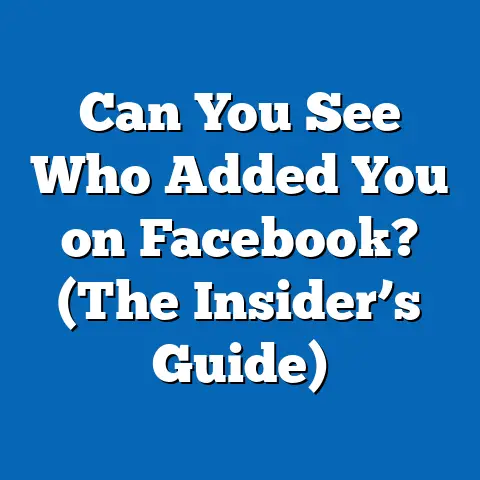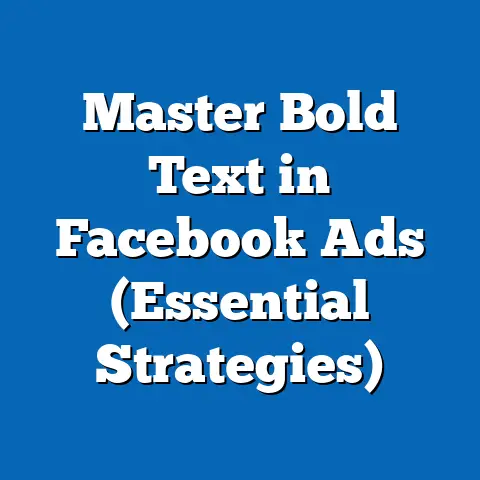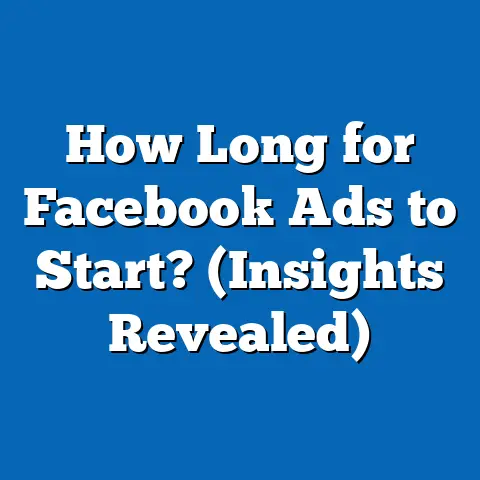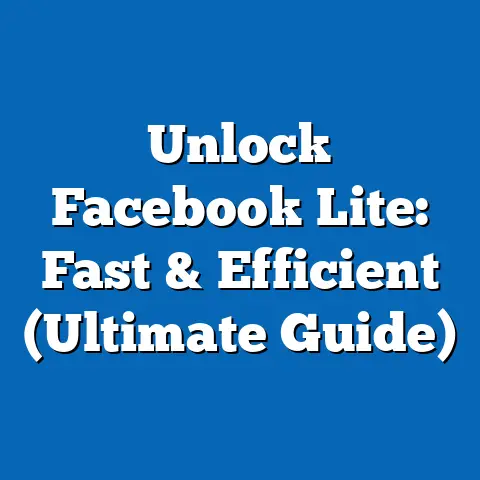Transform Ads into Gold: Facebook Ads Mastery (Expert Guide)
Facebook advertising. It’s a phrase that can either excite you with the potential for growth or make you cringe at the thought of wasted ad spend. I’ve been there, trust me. I remember starting my first Facebook ad campaign years ago, brimming with optimism, only to watch my budget disappear with little to show for it. It was a harsh lesson, but one that fueled my passion for understanding the intricacies of this powerful platform.
The truth is, Facebook advertising can be incredibly lucrative, but only when done right. Think about it: billions of people use Facebook every day. That’s a massive pool of potential customers just waiting to be reached. However, without a solid strategy, well-crafted ads, and a keen understanding of the platform, you’re essentially throwing money into a black hole.
I’ve seen businesses pour thousands of dollars into Facebook ads with little to no return. Why? Because they treat it like a simple task – boost a post here, run a generic ad there – without understanding the underlying mechanics. They’re missing the opportunity to truly “transform ads into gold.”
But what does “transform ads into gold” really mean? It’s about turning your advertising efforts into a consistent, profitable stream of revenue. It’s about understanding your audience, crafting compelling messages, and leveraging the platform’s tools to reach the right people at the right time. It’s about not just spending money, but investing it wisely to achieve tangible results.
Consider this: a recent study showed that businesses that utilize advanced targeting options on Facebook see an average of 20% higher conversion rates. That’s a significant increase that can directly impact your bottom line. Another study revealed that personalized ads, tailored to specific audience segments, have a click-through rate six times higher than generic ads. These aren’t just numbers; they’re proof that a strategic approach to Facebook advertising can yield impressive returns.
Imagine consistently acquiring new customers, boosting brand awareness, and driving sales – all while staying within your budget. That’s the power of Facebook Ads Mastery. It’s not about luck; it’s about knowledge, strategy, and execution.
1. Understanding the Facebook Ads Ecosystem
The Facebook Ads ecosystem can seem overwhelming at first glance. There are so many options, settings, and features that it’s easy to get lost in the details. But trust me, once you understand the basic structure and how everything fits together, it becomes much more manageable. Think of it as learning a new language – start with the alphabet, then move on to words, sentences, and eventually, fluent conversation.
Navigating the Ads Manager Interface
The heart of Facebook advertising is the Ads Manager. This is where you create, manage, and analyze your campaigns. I remember the first time I saw the Ads Manager – it looked like a control panel from a spaceship! But don’t be intimidated. It’s designed to be relatively intuitive, and once you familiarize yourself with the layout, you’ll be navigating it like a pro.
Here’s a breakdown of the key sections:
- Campaigns: This is the top-level structure where you set your overall advertising objective (e.g., awareness, traffic, conversions).
- Ad Sets: Within each campaign, you create ad sets, which define your target audience, budget, schedule, and placement (where your ads will appear).
- Ads: Finally, within each ad set, you create the individual ads that users will see. This includes your headline, copy, visuals, and call-to-action.
The Ads Manager also provides a wealth of data and analytics. You can track the performance of your campaigns, ad sets, and individual ads, allowing you to make informed decisions and optimize your spending. I highly recommend exploring the different reporting options to get a clear picture of what’s working and what’s not.
Different Types of Facebook Ads and Their Use Cases
Facebook offers a variety of ad formats, each designed for specific purposes. Choosing the right format is crucial for maximizing the impact of your ads. Here are some of the most common types:
- Image Ads: These are simple but effective ads that feature a single image or video. They’re great for raising brand awareness, showcasing products, or driving traffic to your website. I’ve found that high-quality, visually appealing images tend to perform best.
- Video Ads: Video ads are incredibly engaging and can be used to tell a story, demonstrate a product, or provide valuable information. They’re particularly effective for capturing attention in a crowded newsfeed. Short, concise videos tend to be more successful than longer ones.
- Carousel Ads: Carousel ads allow you to showcase multiple images or videos in a single ad unit. This format is ideal for highlighting different features of a product, telling a story in sequence, or showcasing a range of products from your catalog.
- Collection Ads: Collection ads are designed for e-commerce businesses. They feature a cover image or video followed by a selection of products from your catalog. This format allows users to browse and purchase products directly from the ad.
- Lead Ads: Lead ads are designed to collect leads directly from Facebook. They include a form that users can fill out without leaving the platform. This format is great for building your email list, generating sales leads, or collecting customer feedback.
- Instant Experience Ads: Instant Experience ads (formerly Canvas Ads) are full-screen, mobile-optimized ads that load instantly when clicked. They can include a combination of images, videos, text, and interactive elements. This format is ideal for creating immersive brand experiences.
When choosing an ad format, consider your advertising objective and target audience. What are you trying to achieve, and what type of content will resonate most with your target audience? Experiment with different formats to see what works best for your business.
The Power of Audience Targeting
One of the biggest advantages of Facebook advertising is its powerful targeting capabilities. Facebook collects a vast amount of data about its users, including their demographics, interests, behaviors, and connections. This data allows you to target your ads to specific groups of people who are most likely to be interested in your products or services.
I remember working with a client who sold organic baby food. Initially, they were running generic ads targeting parents in general. The results were underwhelming. However, once we refined their targeting to focus on parents interested in organic food, natural parenting, and specific baby food brands, their conversion rates skyrocketed.
Here are some of the key targeting options available on Facebook:
- Demographics: You can target users based on age, gender, education, relationship status, job title, and more.
- Interests: You can target users based on their interests, hobbies, and passions. This is based on the pages they like, the groups they join, and the content they interact with on Facebook.
- Behaviors: You can target users based on their past behaviors, such as their purchase history, travel habits, and device usage.
- Connections: You can target users based on their connections to your Facebook page, events, or apps.
- Custom Audiences: Custom Audiences allow you to upload your own customer data (e.g., email addresses, phone numbers) to create targeted audiences on Facebook. This is a powerful way to reach your existing customers or create lookalike audiences (more on that later).
- Lookalike Audiences: Lookalike Audiences allow you to create audiences that are similar to your existing customers or website visitors. This is a great way to expand your reach and find new customers who are likely to be interested in your products or services.
Understanding the Facebook Ads Auction System
Facebook uses an auction system to determine which ads will be shown to users. When you create an ad, you’re essentially bidding for the opportunity to show your ad to your target audience. The auction system takes into account several factors, including your bid amount, ad quality, and estimated action rates.
- Bid Amount: This is the amount you’re willing to pay for each click, impression, or conversion.
- Ad Quality: This is a measure of how relevant and engaging your ad is to your target audience. Facebook uses a variety of factors to determine ad quality, including the quality of your visuals, the relevance of your copy, and the feedback from users.
- Estimated Action Rates: This is Facebook’s prediction of how likely users are to take the desired action (e.g., click on your ad, visit your website, make a purchase).
The auction system is constantly evolving, and Facebook is always working to improve its algorithms. However, the basic principles remain the same: the higher your bid, the better your ad quality, and the higher your estimated action rates, the more likely your ad is to be shown to your target audience.
Key Takeaway: Understanding the Facebook Ads ecosystem is crucial for success. Familiarize yourself with the Ads Manager interface, explore the different ad formats, leverage the power of audience targeting, and understand how the auction system works. This knowledge will provide a solid foundation for creating effective and profitable Facebook ad campaigns.
2. Crafting Compelling Ads
Now that you understand the Facebook Ads ecosystem, let’s dive into the art of crafting compelling ads. This is where creativity meets strategy, and where you can truly make your ads stand out from the crowd. I’ve seen ads that are technically perfect in terms of targeting and bidding, but fail to resonate with the audience because the creative is lackluster. Remember, people are bombarded with ads every day, so you need to grab their attention and make a lasting impression.
The Essential Elements of a Successful Facebook Ad
A successful Facebook ad is more than just a pretty picture and a catchy headline. It’s a carefully crafted message that speaks directly to your target audience, addresses their needs, and inspires them to take action. Here are the essential elements:
- Attention-Grabbing Headline: Your headline is the first thing people will see, so it needs to be compelling enough to stop them from scrolling. Use strong verbs, ask a question, or offer a benefit.
- Engaging Visuals: Images and videos are essential for capturing attention and conveying your message. Use high-quality visuals that are relevant to your target audience and your brand.
- Effective Copywriting: Your ad copy should be clear, concise, and persuasive. Highlight the benefits of your product or service, address your audience’s pain points, and create a sense of urgency.
- Clear Call-to-Action (CTA): Tell people what you want them to do. Use a clear and concise CTA, such as “Learn More,” “Shop Now,” or “Sign Up.”
- Relevance: Your ad should be relevant to your target audience’s interests and needs. Use Facebook’s targeting options to ensure that your ad is shown to the right people.
Tips for Creating Ad Content That Resonates
Creating ad content that resonates with your target audience requires a deep understanding of their needs, desires, and pain points. Put yourself in their shoes and ask yourself:
- What are their biggest challenges?
- What are their goals and aspirations?
- What motivates them to take action?
Once you understand your audience, you can craft ad content that speaks directly to them. Here are some tips:
- Use Customer Language: Use the same language that your target audience uses. This will help them feel understood and connected to your brand.
- Highlight Benefits, Not Just Features: Focus on the benefits of your product or service, not just the features. Explain how your product or service will solve their problems or improve their lives.
- Tell a Story: Stories are a powerful way to connect with your audience on an emotional level. Use storytelling to illustrate the benefits of your product or service and create a memorable ad experience.
- Use Social Proof: Social proof, such as testimonials, reviews, and case studies, can help build trust and credibility. Include social proof in your ads to show potential customers that others have had positive experiences with your product or service.
- Create a Sense of Urgency: Create a sense of urgency to encourage people to take action. Use phrases like “Limited Time Offer,” “While Supplies Last,” or “Don’t Miss Out.”
The Power of A/B Testing
A/B testing is the process of comparing two versions of an ad to see which one performs better. This is a crucial step in refining your ad campaigns and improving their effectiveness over time. I’ve seen campaigns that were performing poorly turn around completely after implementing a few simple A/B tests.
Here are some things you can A/B test:
- Headlines: Test different headlines to see which one grabs the most attention.
- Visuals: Test different images and videos to see which ones are most engaging.
- Copy: Test different ad copy to see which one is most persuasive.
- CTAs: Test different CTAs to see which one generates the most clicks.
- Targeting: Test different targeting options to see which audience segments are most responsive.
When A/B testing, it’s important to only change one variable at a time. This will allow you to isolate the impact of each change and determine which version is truly performing better. Also, be sure to run your tests for a sufficient amount of time to gather enough data to make statistically significant conclusions.
Key Takeaway: Crafting compelling ads is essential for success on Facebook. Focus on creating attention-grabbing headlines, engaging visuals, effective copywriting, and clear CTAs. Understand your target audience and create ad content that resonates with their needs and desires. And don’t forget the power of A/B testing to refine your campaigns and improve their performance over time.
3. Targeting Your Audience
I cannot stress enough how crucial audience targeting is to the success of your Facebook ad campaigns. You can have the most beautifully crafted ad in the world, but if it’s shown to the wrong people, it’s essentially a waste of money. Think of it like trying to sell snowboards in the desert – you might get a few curious glances, but you’re unlikely to make many sales.
Facebook’s targeting options are incredibly powerful, allowing you to reach specific groups of people based on a wide range of factors. Mastering these options is essential for maximizing the impact of your ads and achieving your advertising goals.
Understanding Facebook’s Targeting Options
As I mentioned earlier, Facebook offers a variety of targeting options, including:
- Demographics: Age, gender, education, relationship status, job title, etc.
- Interests: Hobbies, passions, pages they like, groups they join, etc.
- Behaviors: Purchase history, travel habits, device usage, etc.
- Connections: Connections to your Facebook page, events, or apps.
- Custom Audiences: Audiences based on your own customer data (e.g., email addresses, phone numbers).
- Lookalike Audiences: Audiences that are similar to your existing customers or website visitors.
Each of these options can be used to create highly targeted audiences that are more likely to be interested in your products or services. For example, if you’re selling running shoes, you could target users who are interested in running, fitness, and healthy living. You could also target users who have recently purchased running shoes online or who are members of running clubs.
Leveraging Custom Audiences
Custom Audiences are a game-changer for Facebook advertising. They allow you to leverage your existing customer data to create targeted audiences on Facebook. This is a powerful way to reach your existing customers, re-engage past customers, or create lookalike audiences.
There are several ways to create Custom Audiences:
- Customer List: You can upload a list of email addresses, phone numbers, or other customer data to create a Custom Audience. Facebook will match this data to users on its platform and create a targeted audience.
- Website Traffic: You can create a Custom Audience based on people who have visited your website. This requires installing the Facebook Pixel on your website (more on that later).
- App Activity: You can create a Custom Audience based on people who have used your mobile app.
- Engagement: You can create a Custom Audience based on people who have engaged with your content on Facebook, such as liking your page, watching your videos, or clicking on your ads.
I’ve found that Customer List Custom Audiences are particularly effective for re-engaging past customers. For example, if you have a list of customers who haven’t purchased from you in a while, you can create a Custom Audience and target them with special offers or promotions.
The Magic of Lookalike Audiences
Lookalike Audiences are one of the most powerful targeting tools on Facebook. They allow you to create audiences that are similar to your existing customers or website visitors. This is a great way to expand your reach and find new customers who are likely to be interested in your products or services.
To create a Lookalike Audience, you need to provide Facebook with a source audience. This can be a Custom Audience, a Facebook page audience, or a website audience. Facebook will then analyze the characteristics of the source audience and create a new audience that is similar to it.
I’ve seen businesses achieve incredible results by using Lookalike Audiences. For example, I worked with a client who sold high-end skincare products. They created a Lookalike Audience based on their existing customers and targeted them with ads showcasing their new product line. The results were phenomenal – their conversion rates doubled, and their sales skyrocketed.
The Importance of Audience Segmentation
Audience segmentation is the process of dividing your target audience into smaller, more specific groups based on shared characteristics. This allows you to create more personalized and effective advertising campaigns.
For example, instead of targeting all women aged 25-45, you could segment your audience based on their interests, behaviors, or purchase history. You could create separate audiences for women interested in fashion, women interested in fitness, and women interested in travel.
By segmenting your audience, you can tailor your ad content to their specific needs and interests. This will make your ads more relevant and engaging, leading to higher click-through rates and conversion rates.
Key Takeaway: Audience targeting is crucial for the success of your Facebook ad campaigns. Understand Facebook’s targeting options, leverage Custom Audiences and Lookalike Audiences, and segment your audience to create more personalized and effective advertising campaigns. The more targeted your ads are, the more likely you are to achieve your advertising goals.
4. Budgeting and Bidding Strategies
So, you’ve crafted compelling ads and identified your ideal audience. Now comes the crucial part: setting your budget and choosing the right bidding strategy. This is where many businesses stumble, either overspending without seeing results or underspending and missing out on potential opportunities. I’ve learned that finding the right balance is key to maximizing your ROI on Facebook.
Setting Your Facebook Ads Budget
Determining the right budget for your Facebook ads can feel like a guessing game, but it doesn’t have to be. There’s no one-size-fits-all answer, as the optimal budget will depend on a variety of factors, including your advertising goals, target audience, industry, and competition.
Here are some things to consider when setting your budget:
- Your Advertising Goals: What are you trying to achieve with your Facebook ads? Are you trying to raise brand awareness, drive traffic to your website, generate leads, or make sales? Your budget should be aligned with your advertising goals.
- Your Target Audience: How large is your target audience? The larger your target audience, the more you’ll need to spend to reach them effectively.
- Your Industry: How competitive is your industry? If you’re in a highly competitive industry, you’ll need to spend more to stand out from the crowd.
- Your Competition: What are your competitors spending on Facebook ads? This can give you a sense of what it takes to be competitive in your market.
Facebook offers two types of budgets:
- Daily Budget: This is the average amount you’re willing to spend per day. Facebook will try to spend this amount each day, but it may spend slightly more or less depending on the performance of your ads.
- Lifetime Budget: This is the total amount you’re willing to spend over the entire duration of your campaign. Facebook will try to distribute your budget evenly over the campaign period, but it may spend more or less on certain days depending on the performance of your ads.
I generally recommend starting with a daily budget, as it gives you more control over your spending. You can always adjust your budget as needed based on the performance of your ads.
Understanding Facebook’s Bidding Strategies
Facebook offers a variety of bidding strategies, each designed for different advertising goals. Choosing the right bidding strategy is essential for maximizing your ROI. Here are some of the most common bidding strategies:
- Highest Volume: This is the default bidding strategy. Facebook will try to get you the most results for your budget, regardless of cost per result. This strategy is best for campaigns focused on brand awareness or traffic.
- Cost Per Result Goal: This strategy allows you to set a target cost per result (e.g., cost per click, cost per lead, cost per conversion). Facebook will try to get you results at or below your target cost. This strategy is best for campaigns focused on lead generation or sales.
- Value Optimization: This strategy is available for campaigns focused on sales. Facebook will try to get you the highest value conversions for your budget. This strategy requires setting up conversion tracking and assigning values to your conversions.
- Manual Bidding: This strategy allows you to manually set your bids for each auction. This gives you more control over your spending, but it also requires more expertise.
I typically recommend starting with the “Cost Per Result Goal” bidding strategy, as it allows you to control your spending and optimize for specific outcomes. However, it’s important to experiment with different bidding strategies to see what works best for your business.
Monitoring and Adjusting Your Budget
Setting your budget and choosing a bidding strategy is just the first step. It’s also important to monitor your ad spend and adjust your budget based on the performance of your ads.
Here are some things to monitor:
- Ad Spend: How much are you spending each day? Are you staying within your budget?
- Cost Per Result: How much are you paying for each click, lead, or conversion? Are you meeting your target cost per result?
- Return on Ad Spend (ROAS): How much revenue are you generating for every dollar you spend on ads?
If you’re not meeting your target cost per result or ROAS, you may need to adjust your budget or bidding strategy. You may also need to refine your targeting or ad creative.
Key Takeaway: Setting your budget and choosing the right bidding strategy is crucial for maximizing your ROI on Facebook. Consider your advertising goals, target audience, industry, and competition when setting your budget. Experiment with different bidding strategies to see what works best for your business. And don’t forget to monitor your ad spend and adjust your budget based on the performance of your ads.
5. Analyzing and Optimizing Performance
You’ve launched your campaigns, set your budget, and targeted your audience. But the work doesn’t stop there. In fact, this is where the real magic happens: analyzing your results and optimizing your campaigns for peak performance. I’ve seen countless campaigns go from mediocre to outstanding simply by paying close attention to the data and making informed adjustments.
Key Performance Indicators (KPIs) for Facebook Ads
To effectively analyze your performance, you need to understand the key performance indicators (KPIs) that matter most. These are the metrics that will give you insights into how your ads are performing and where you can make improvements. Here are some of the most important KPIs for Facebook ads:
- Impressions: The number of times your ad was shown to users. This is a measure of your ad’s reach.
- Reach: The number of unique users who saw your ad. This is another measure of your ad’s reach.
- Click-Through Rate (CTR): The percentage of users who saw your ad and clicked on it. This is a measure of your ad’s relevance and engagement.
- Cost Per Click (CPC): The amount you paid for each click on your ad. This is a measure of your ad’s efficiency.
- Conversion Rate: The percentage of users who clicked on your ad and completed a desired action (e.g., made a purchase, filled out a form). This is a measure of your ad’s effectiveness.
- Cost Per Conversion (CPC): The amount you paid for each conversion. This is a measure of your ad’s efficiency.
- Return on Ad Spend (ROAS): The amount of revenue you generated for every dollar you spent on ads. This is a measure of your ad’s profitability.
Using Facebook Ads Insights
Facebook Ads Insights is a powerful tool that provides a wealth of data and analytics about your ad campaigns. You can use Ads Insights to track the performance of your campaigns, ad sets, and individual ads, allowing you to make informed decisions and optimize your spending.
Here are some of the things you can do with Facebook Ads Insights:
- Track Key Performance Indicators: Monitor your impressions, reach, CTR, CPC, conversion rate, CPC, and ROAS.
- Analyze Audience Demographics: Understand the demographics of the users who are seeing and engaging with your ads.
- Identify Top-Performing Ads: See which ads are generating the most clicks, conversions, and revenue.
- Compare Performance Across Ad Sets: Compare the performance of different ad sets to see which targeting options are most effective.
- Track Website Conversions: Track the conversions that are happening on your website as a result of your Facebook ads (requires installing the Facebook Pixel).
I recommend spending time exploring Facebook Ads Insights and familiarizing yourself with the different reporting options. The more you understand your data, the better equipped you’ll be to optimize your campaigns.
The Importance of Continuous Improvement
The world of Facebook advertising is constantly evolving. Facebook is always updating its algorithms, introducing new features, and changing its policies. To stay ahead of the curve, you need to adopt a mindset of continuous improvement.
This means constantly analyzing your results, experimenting with new strategies, and adapting to changes in the platform. It also means staying up-to-date on the latest trends and best practices.
Here are some things you can do to foster a culture of continuous improvement:
- Set Clear Goals: Define your advertising goals and track your progress towards them.
- Regularly Analyze Your Results: Spend time each week reviewing your data and identifying areas for improvement.
- Experiment with New Strategies: Don’t be afraid to try new things. Test different targeting options, ad creatives, and bidding strategies.
- Stay Up-to-Date on the Latest Trends: Follow industry blogs, attend webinars, and network with other marketers to stay informed about the latest trends and best practices.
- Document Your Findings: Keep a record of your experiments and their results. This will help you learn from your mistakes and build on your successes.
Key Takeaway: Analyzing and optimizing performance is crucial for success on Facebook. Understand your KPIs, use Facebook Ads Insights to track your results, and adopt a mindset of continuous improvement. The more you analyze, experiment, and adapt, the better your results will be.
6. Advanced Strategies for Facebook Ads Mastery
Now that you have a solid grasp of the fundamentals, let’s explore some advanced strategies that can take your Facebook advertising to the next level. These techniques require a bit more expertise, but they can yield remarkable results if implemented correctly. I’ve seen businesses achieve exponential growth by leveraging these advanced strategies.
Retargeting: Reaching Engaged Users
Retargeting is the practice of showing ads to people who have previously interacted with your brand. This could include people who have visited your website, viewed your products, added items to their cart, or engaged with your content on Facebook.
Retargeting is incredibly effective because you’re reaching people who are already familiar with your brand and have shown some level of interest in your products or services. They’re more likely to click on your ads, visit your website, and make a purchase.
To implement retargeting, you need to install the Facebook Pixel on your website. The Facebook Pixel is a small piece of code that tracks the actions that users take on your website. This data is then used to create retargeting audiences on Facebook.
I’ve found that retargeting ads with special offers or promotions can be particularly effective. For example, if someone added an item to their cart but didn’t complete the purchase, you could show them a retargeting ad offering a discount or free shipping.
Dynamic Ads: Personalizing the Ad Experience
Dynamic ads are a type of ad that automatically shows users products or services that they’re most likely to be interested in. This is based on their past behavior on your website or app.
For example, if someone viewed a specific product on your website, you could show them a dynamic ad featuring that product. Or, if someone added an item to their cart but didn’t complete the purchase, you could show them a dynamic ad reminding them about the item in their cart.
Dynamic ads are highly personalized and relevant, which makes them incredibly effective. They can significantly increase your click-through rates, conversion rates, and revenue.
To implement dynamic ads, you need to upload your product catalog to Facebook. You also need to install the Facebook Pixel on your website and track the actions that users take on your website.
Facebook Pixel Implementation: The Foundation for Success
The Facebook Pixel is a small piece of code that you install on your website. It tracks the actions that users take on your website, such as visiting pages, viewing products, adding items to their cart, and making purchases.
The Facebook Pixel is essential for several reasons:
- Retargeting: It allows you to create retargeting audiences based on people who have visited your website.
- Conversion Tracking: It allows you to track the conversions that are happening on your website as a result of your Facebook ads.
- Dynamic Ads: It’s required for implementing dynamic ads.
- Optimization: It provides data that Facebook can use to optimize your ad campaigns.
Installing the Facebook Pixel is relatively straightforward. You simply need to copy the code and paste it into the header of your website. There are also plugins available for popular content management systems like WordPress and Shopify that can make the process even easier.
Integrating Facebook Ads with Other Channels
Facebook ads shouldn’t exist in a silo. To maximize your marketing ROI, you need to integrate your Facebook ads with your other marketing channels, such as email marketing, content marketing, and search engine optimization (SEO).
For example, you could use Facebook ads to drive traffic to your blog posts. Or, you could use email marketing to nurture leads that you generated from Facebook ads. You could also use SEO to improve the visibility of your website in search results, making it easier for people to find you after seeing your Facebook ads.
Key Takeaway: Advanced strategies like retargeting, dynamic ads, and Facebook Pixel implementation can take your Facebook advertising to the next level. These techniques require a bit more expertise, but they can yield remarkable results. Don’t forget to integrate your Facebook ads with your other marketing channels to maximize your ROI.
Remember, Facebook advertising is not a set-it-and-forget-it endeavor. It requires ongoing effort, analysis, and optimization. But with dedication and expertise, you can achieve remarkable results.
Here are some key takeaways to keep in mind:
- Understand the Facebook Ads Ecosystem: Familiarize yourself with the Ads Manager interface, explore the different ad formats, leverage the power of audience targeting, and understand how the auction system works.
- Craft Compelling Ads: Focus on creating attention-grabbing headlines, engaging visuals, effective copywriting, and clear CTAs. Understand your target audience and create ad content that resonates with their needs and desires.
- Target Your Audience: Leverage Custom Audiences and Lookalike Audiences, and segment your audience to create more personalized and effective advertising campaigns.
- Budget and Bid Strategically: Consider your advertising goals, target audience, industry, and competition when setting your budget. Experiment with different bidding strategies to see what works best for your business.
- Analyze and Optimize Performance: Understand your KPIs, use Facebook Ads Insights to track your results, and adopt a mindset of continuous improvement.
- Embrace Advanced Strategies: Explore retargeting, dynamic ads, and Facebook Pixel implementation to take your Facebook advertising to the next level.
Now, it’s time to take action. Start by implementing the strategies we’ve discussed in this guide. Experiment with different approaches and track your results. Don’t be afraid to make mistakes – they’re part of the learning process.
With perseverance and a commitment to continuous improvement, you can transform your Facebook ads into a powerful engine for growth and profitability. Remember, transforming ads into gold is an achievable goal with the right knowledge and execution. Good luck!

